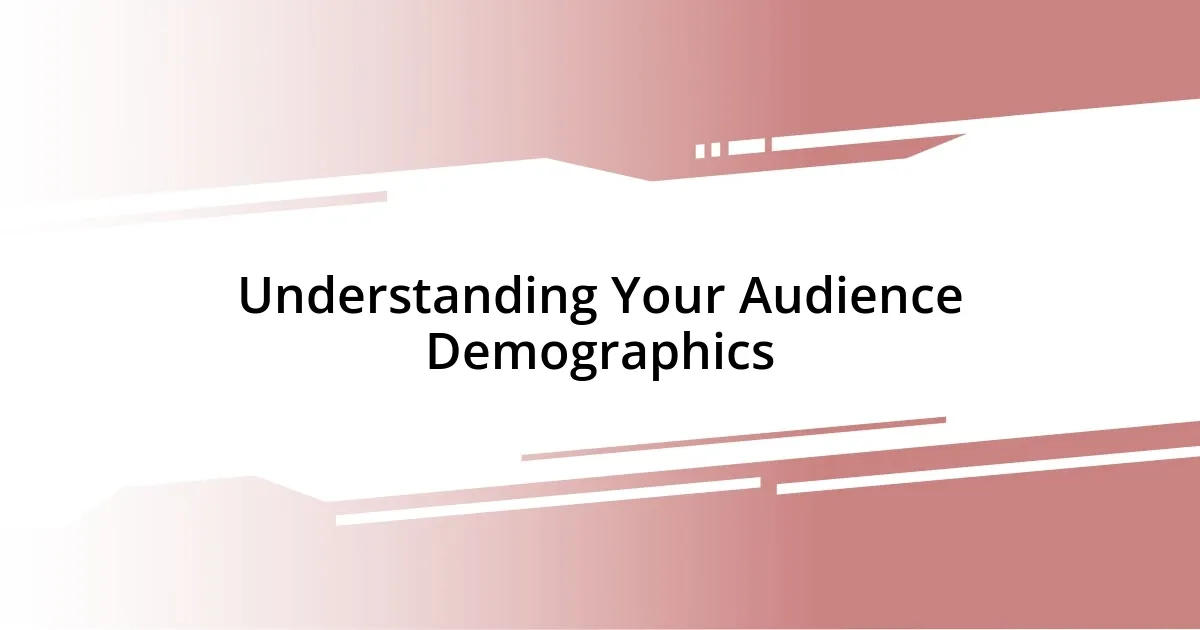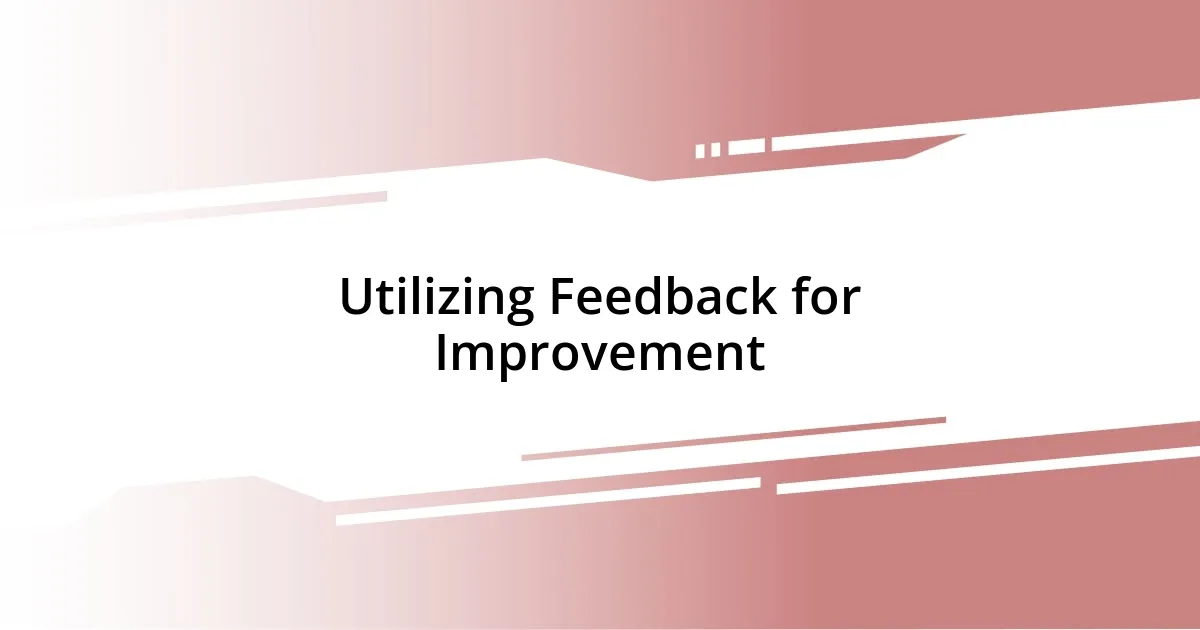Key takeaways:
- Clearly defined objectives enhance participant engagement and foster a positive emotional environment during workshops.
- Understanding audience demographics is essential for tailoring content and creating an inclusive learning atmosphere.
- Effective facilitation techniques, such as using open-ended questions and maintaining a good pacing, elevate discussions and participant involvement.
- Utilizing feedback for continuous improvement and implementing follow-up strategies transform one-time interactions into lasting relationships and deeper learning experiences.

Defining Objectives for Workshops
Defining objectives for workshops is crucial. I remember one workshop where I started without clear goals, and it felt like navigating without a map. Do you think participants leave feeling fulfilled when the purpose isn’t clear?
When I took the time to outline specific objectives, I noticed a shift in energy and participation. For instance, setting a goal to enhance teamwork skills in a recent workshop led to vibrant discussions and hands-on activities. I could almost feel the excitement in the room as everyone worked toward this shared aim.
Moreover, I’ve learned that objectives should not just be about what we want to teach, but how we want participants to feel and interact. It’s about creating an environment where they can thrive and grow. What kind of emotional impact do you want your participants to carry home with them? Each objective should resonate on that level.

Understanding Your Audience Demographics
Understanding the demographics of your audience is a game-changer for any workshop leader. I recall facilitating a session primarily aimed at young professionals, and it became clear that their interests revolved around networking and career growth. This insight helped me tailor my content to address their aspirations, instantly increasing engagement and interaction.
Moreover, age, cultural background, and professional experience can dramatically shape participant expectations. I once led a diverse group where the younger attendees craved interactive exercises while the seasoned professionals valued in-depth dialogue. Balancing these needs required me to adapt my approach on the fly, blending different teaching styles to ensure inclusivity. It was a rewarding challenge that enriched the entire experience.
Understanding your audience isn’t just about gathering data; it’s about connecting with them on a deeper level. I find that when I incorporate elements that resonate, such as relatable examples or industry-specific scenarios, the room transforms into a dynamic space where everyone feels involved. Have you ever noticed how a shared interest can light up the engagement in a workshop? I have, and it’s a powerful reminder of why knowing your audience demographics matters.
| Audience Demographic | Implications for Workshops |
|---|---|
| Age | Tailor content complexity and engagement level |
| Cultural Background | Incorporate diverse perspectives and examples |
| Professional Experience | Balance interactive learning with deep discussions |

Designing Engaging Workshop Activities
Designing engaging workshop activities is all about sparking curiosity and fostering participation. I remember a workshop I led where I introduced a role-playing exercise. At first, I noticed some hesitant faces, but the transformation was incredible once they began to immerse themselves in their roles. There was laughter, creativity, and genuine collaboration, creating a vibrant atmosphere that breathed life into our discussions. The key is to choose activities that not only align with your objectives but also resonate with the participants’ interests.
To help you design meaningful activities, consider these elements:
- Interactive Games: Use icebreakers or team-building activities to promote connection and ease tension.
- Hands-On Learning: Incorporate real-life scenarios or case studies to ground concepts in reality.
- Visual Aids: Utilize charts, infographics, or videos to cater to different learning styles and keep attention.
- Feedback Loops: Implement quick reflection sessions where participants share thoughts or insights, increasing ownership of their learning.
- Breakout Groups: Encourage smaller group discussions to foster deeper conversations and peer connections.
When I integrate these elements, I observe participants not just learning but experiencing the material, making for a more impactful workshop. Embrace creativity, and you’ll see the energy in the room shift dramatically!

Techniques for Effective Facilitation
Facilitating effectively demands an adaptable mindset. I recall a time when I led a workshop on conflict resolution. As discussions began to heat up, I had to quickly shift my approach from lecture mode to a more guided dialogue. This pivot not only calmed the room but also encouraged participants to share their perspectives openly. The lesson? Being responsive to the moment can elevate the discussions in unexpected ways.
Another technique I’ve found beneficial is the power of open-ended questions. I remember when I prompted a group to consider, “What does success look like to you?” The silence that followed made me nervous at first. But then, one by one, participants started sharing intimate stories about their journeys. That moment of vulnerability built a sense of trust and community. It reinforced my belief that asking the right questions can unlock a treasure trove of insights.
I’ve also learned the importance of pacing during a workshop. Balancing the delivery of information with interactive activities keeps energy levels high. In one workshop, I introduced quick brainstorming sessions after each key point. This not only allowed participants to digest the information but also transformed the atmosphere into one of collaboration and excitement. Have you ever tried to figure out the right rhythm in your sessions? When you do, it can turn an ordinary workshop into a memorable experience that participants rave about long after it concludes.

Utilizing Feedback for Improvement
Utilizing feedback is a crucial part of my workshop journey. I remember a session where, at the end, I asked participants to fill out a quick, anonymous survey. As I reviewed the responses later, there were a few candid criticisms that stung initially, but they were invaluable for my growth. Hearing that my explanations were sometimes too fast made me recognize the need to adapt my pacing to better suit all learners.
One specific piece of feedback that resonated with me was when someone suggested more visual aids during discussions. Initially, I thought my points were clear enough, but this prompted me to introduce diagrams in my next workshop. It was a game-changer! Participants engaged more deeply and felt the material was more accessible. Have you ever overlooked something until someone else pointed it out? That moment of realization can spark a positive transformation.
Feedback isn’t just about collecting data; it’s an ongoing dialogue with your participants. After implementing changes based on their input, I invite them to share their thoughts again. It’s thrilling to watch them take ownership of their learning experience, feeling valued for their contributions. Isn’t it extraordinary how a simple request for feedback can build a richer, more collaborative atmosphere? Through this practice, I continue to refine my methods, ensuring that each workshop feels tailored to the unique group before me.

Building a Follow-Up Strategy
Building a follow-up strategy has become a cornerstone of my workshops. I vividly remember a training session where I dedicated a few minutes at the end to discuss next steps. I asked participants what kind of support they needed post-workshop, and the range of responses surprised me. Some were craving accountability, while others wanted resources to dive deeper. It showed me that a simple follow-up conversation could significantly enhance participants’ commitment to applying what they learned.
Creating an effective follow-up strategy transcends simple reminders. After one workshop on time management, I sent out personalized emails, not just thanking participants, but also sharing tailored tips based on our discussions. The enthusiastic replies revealed that this approach made them feel seen and supported. It’s fascinating to think about how a thoughtful follow-up can transform a one-time interaction into a long-lasting relationship. Have you ever reached out after an event and found that participants appreciated it more than you anticipated?
I also discovered that utilizing various communication channels can amplify engagement. After implementing a private Facebook group post-workshop, I was overwhelmed by the discussions that followed. Seeing participants share their successes and struggles in real-time cultivated a sense of community that I never expected. Isn’t it powerful how ongoing conversations can keep the momentum alive? It’s these connections that reinforce the workshop’s impact, ensuring that participants don’t just remember the content but feel inspired to carry it forward in their lives.

Measuring Workshop Success and Impact
Measuring the success of a workshop goes beyond just the applause at the end. For me, it’s about observing the ‘aha’ moments during the session. I recall one particular workshop where a participant expressed her breakthrough when she finally understood a challenging concept. That glowing smile and relieved laughter were more valuable than any numerical metric. Have you ever seen someone’s eyes light up with understanding? It’s a reminder that real success lies in those transformative experiences.
Another effective way I’ve gauged impact is through follow-up conversations. In my last workshop, I reached out a month later to discuss how everyone was applying what they learned. One participant shared a story that brought tears to my eyes—she had used our techniques to make significant changes in her workplace. This kind of feedback truly illustrates the lasting impact of my workshops and shows that metrics like participant retention or survey scores don’t always capture the heart of learning. How do you quantify a life changed?
Finally, I’ve learned the importance of establishing concrete outcomes. In a recent workshop, I encouraged participants to set personal goals based on our discussions. A few weeks later, I gathered their success stories, and the diversity of improvements—from productivity boosts to healthier work-life balances—was astonishing. Isn’t it inspiring to see how different approaches can lead to meaningful change? Measuring impact becomes a tapestry of personal victories, where each thread tells a unique story of growth and realization.














